-
Paper Information
- Paper Submission
-
Journal Information
- About This Journal
- Editorial Board
- Current Issue
- Archive
- Author Guidelines
- Contact Us
International Journal of Arts
p-ISSN: 2168-4995 e-ISSN: 2168-5002
2016; 6(2): 46-50
doi:10.5923/j.arts.20160602.02

Fabrication of Axel (Potter’s) Kick Wheel for the Production of Ceramics
Etuokwu Anthony Obiy1, Uzzi Festus Osarumwense2
1Department of Fine and Applied Arts, Niger Delta University, Nigeria
2Department of Fine and Applied Arts, Olabisi Onabanjo University, Nigeria
Correspondence to: Etuokwu Anthony Obiy, Department of Fine and Applied Arts, Niger Delta University, Nigeria.
| Email: |  |
Copyright © 2016 Scientific & Academic Publishing. All Rights Reserved.
This work is licensed under the Creative Commons Attribution International License (CC BY).
http://creativecommons.org/licenses/by/4.0/

The wheel is simple equipment which every studio potter desires. There is no complete ceramics studio or workshop without a potter’s wheel. Suffice to say that the potter’s wheel is an important icon in the pottery studio and in the making of pottery products. The implication of this is that the potter’s wheel is indispensable ceramic equipment necessary in the ceramics processing. Unfortunately, though, observations in some established ceramic units in most of our tertiary institutions and some pottery homes today has revealed the absence of some of the vital equipment’s for pottery making, in which the potter’s wheel is one. This could be adduced to the high cost of procuring such equipment. Recently however, in the quest for self–reliance, most potters have taken to fabrication of local machinery and equipment. In that same manner therefore, this paper documents an illustrated step-by-step approach in the designing and fabrication of a simple potter’s kick wheel using the motor axel at a minimum of cost. The fabrication was completed and the equipment was subjected to a vigorous test by using it to produce some ceramic wares, and it was found to be very effective. This document will therefore serve as a call to potential potters from developing countries to attempt fabrication of equipment necessary for the ceramic studios. It finally concludes by recommending the equipment to every ceramic studio, pottery homes and to individual potters.
Keywords: Fabrication, Axel, Kick wheel, Studio potters and Production
Cite this paper: Etuokwu Anthony Obiy, Uzzi Festus Osarumwense, Fabrication of Axel (Potter’s) Kick Wheel for the Production of Ceramics, International Journal of Arts, Vol. 6 No. 2, 2016, pp. 46-50. doi: 10.5923/j.arts.20160602.02.
Article Outline
1. Introduction
- The quest for the fabrication of local machinery and equipment as well as self-reliant and self-sufficiency advocacy, has compelled many developing countries such as Nigeria where power energy “Electricity” is not guarantee to power ceramics equipment anytime, including researchers in the universities, to go into fabrications of some vital and/ necessary equipment’s. This is evident in the various workshops, conferences, seminars and even in final year student’s project works in the Universities. The potter’s wheel is one of such projects. The wheel is simple equipment which every studio potter desires. A simple manual wheel may have just the wheel head and a flywheel, suspended on a rigid wooden or metal stand and is being operated with the hand or foot. The wheel head necessarily has to be heavy to enable the machine gather enough momentum for the required speed during the operation. In the wards of Leach (1976. 67), he says, the wheel “--- consist of a wheel-head, or disk, which revolves with considerable momentum and smooth control of speed and is driven by hand or foot, or by gear. The momentum is obtained from either a heavy wheel-head or from a fly wheel.” However, some of the wheels have always been associated with one problem or the other. The electric wheel has not been a total solution to the potter’s problem in this regard because of the epileptic power supply in our various communities today. One of the goals of embarking on a manual potter’s wheel is to “ensure that its adaptability shall adequately provide efficiency even in the absence of electricity, making it a dependable source for production of pottery wares” (Agberia 1999:18). The non-availability of the potter’s wheel in the ceramic studio has therefore posed a big challenge to the potter and as such, demands for urgent solution. Attempts are therefore made to construct a potter’s wheel using the motor axel, to alleviate the potters challenge in the quest for a reliable wheel that will stand the test of time for his pottery production. In the words of Norton (1956. 21), he says “The wheel is the tool of the potter, allowing him to use his skill to quickly produce beautifully shaped pieces, so that they have the freshness and vitality of quick sketches”. The wheel is an indispensable and useful tool in the ceramic studio for the production of hollowed ceramic wares, and at the same time its presence enriches the studio environment. Previously however, the axel wheel has been designed by the researcher but with a difference in the operating system; which he regards as being cumbersome, hence the new. In the old design, it was constructed such that it was operated by two persons. While one person is turning the wheel, the other is modeling on the wheel head. (See plate 1). This is somewhat difficult as there could be occasional break in concentration and coordination between the two persons.
 | Plate 1. Hand Turning Axel Potter’s Wheel |
2. Requirements
- Some of the materials required for the construction of the axel potters kick wheel are as follows- 1. Motor car axel2. Medium size ‘H’ iron rod (or any other solid metal)3. 10mm thick metal plate4. 18-gauge galvanized pan5. 3.8cm angle iron bar 6. 18mm bolts and nuts7. Welding equipment.
3. Construction Procedure
- The Framework: - The framework is a three footed assembly, rigidly welded in places to support the weight of the motor axel, the lump of clay and the potter himself. The legs are constructed with a solid and robust ‘H’ metal rod or a 5cm galvanized pipe to attain the necessary rigidity and stability. In the wards of Primmer (1974 .194), he says “---to obtain the necessary rigidity in the framework it is best to use welded metal construction---”. However, any other solid metal rod (or hard wood) could be used. This is braced together with angle iron bars to form a rigid structure for stability and durability. (Plate 2).
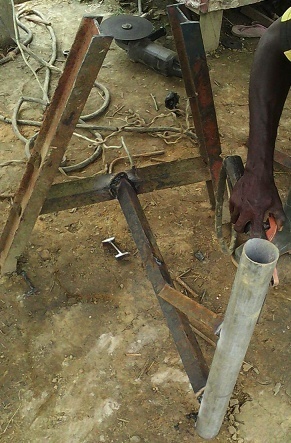 | Plate 2. Framework and Stand for the Wheel |
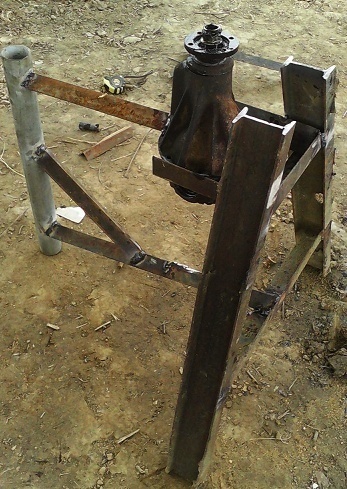 | Plate 3. The Seating for the Motor Axel with the Axel Mounted |
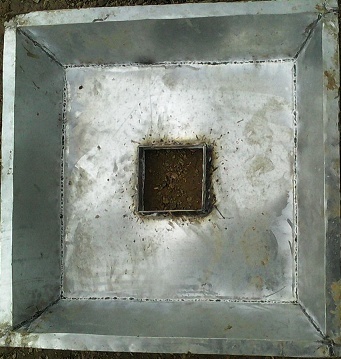 | Plate 4. The Splash Tray |
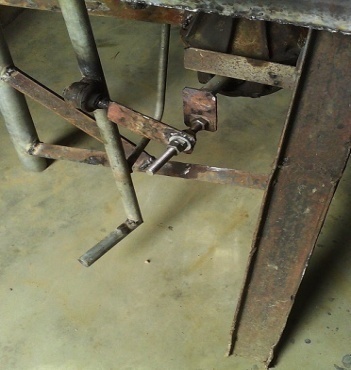 | Plate 5. The Assembly of the Foot Pedal |
 | Plate 6. The Wheel Head |
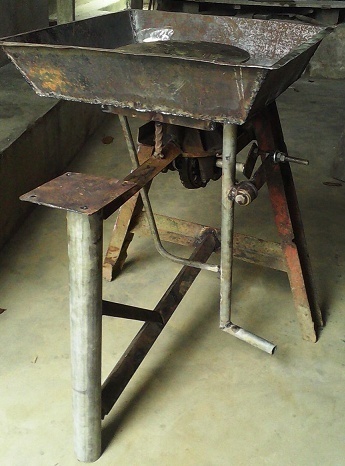 | Plates 7. The Completed and Assembled Axel (Kick) Wheel |
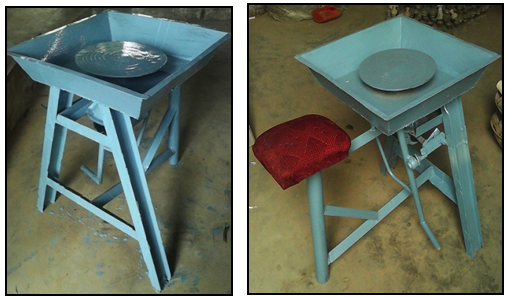 | Plates 8. a & b. The Axel (Potter’s) Kick Wheel |
4. Features
- This axel kick wheel was designed and constructed taking efficiency and economy as first priority with emphasis on the following features:1. Ruggedness, the framework is a robust construction, finished with heavy gauge metal iron bars and rods. 2. Very minimal effort is required in kicking the foot pedal to attain the required speed for throwing. 3. The wheel is fitted with a galvanized splash tray as receptacle for both water and the clay slurry to eliminate messy working environment. 4. The potter’s seat is finished with a padded upholstery material for the comfort of the potter.5. The maintenance cost is very minimal.6. The wheel is well engineered for rapid and reliable mass production of ceramic wares.7. The operating mechanism is reversible. It operates both clockwise or counter clockwise for both left hand and right hand throwers.
5. Analysis, Conclusions and Recommendations
- In a developing countries such as Nigeria where there is this advocacy for self-reliance and self-sufficiency in the development of machinery and equipment, it has become necessary for potters to individually fabricate various types of equipment including the potter’s wheels locally to equip their various studios in order to facilitate pottery production. Constructing and managing a homemade potter’s wheel is a challenging venture and most potters manage to improvise one for self sometime. Apart from the savings one makes by constructing your own equipment, like the potter’s wheel, there is also the joy and satisfaction in having constructed a successful wheel and using it too. There is nothing like getting on and doing it yourself; solving problems as you go along really helps you understand the equipment, its construction, functioning and maintenance the more. However, a great deal of thought, calculations and research has gone into the fabrication of this very efficient equipment and I hope it will go a long way to alleviate some of the challenges encountered by most potters. This wheel can conveniently compare with the electric wheel in performance as it takes very minimal effort and energy to operate. It is however very important to use the best material to construct new equipment because it pays. The quality and ruggedness of the component parts and craftsmanship are superior and the machine is powerful enough to center upwards of 5kg of clay. It is designed for rigorous use in the studio and perfect for anyone from the beginner (armature) to professional. The necessary materials for the construction of this wheel can be purchased within any local environment. Therefore, there is the possibility of fabricating high quality potter’s wheels locally for the manufacture of pottery in ceramic studios.The wheel addresses the latest generation of production machines which is geared towards meeting a variety of important needs, including increased productivity, control and reduced energy consumption. It has been developed to meet the increasing urge for the mass production of ceramic wares. For an individual running a small pottery or a cottage ceramic industry, this machine will play an indispensable role. Products are made in few minutes with ease and for a good professional potter (thrower), he could produce quite a reasonable number of pots within a very short period, depending on his throwing speed. Pottery can hardly be discussed completely without the knowledge or reference to throwing on the potter’s wheel. The absence of a potter’s wheel in a pottery studio or workshop reduces such workshop to an incomplete one. Potter’s knowledge of the wheel has made it possible to conveniently mass produce ceramic wares by professional potters with ease. This research paper therefore should serve as a call as well as a challenge to interested studio potters to pick up interest in the fabrication of vital equipment for their own studio use, rather than resorting to purchasing from the market at exorbitant rate. It is hoped that this axel kick wheel will aid in the development of functional and practical knowledge of ceramics as well as be an eye opener to researchers in other research areas of machinery fabrication and acquisition. It will also encourage effective learning program for ceramic enthusiasts.
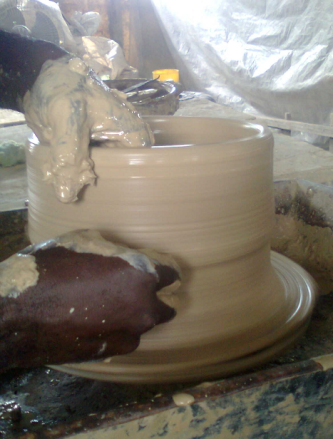 | Plate 9. The machine is powerful enough to center large lumps of clay |
 | Plate 10. The wheel aids mass production of wares by competent potters |
 Abstract
Abstract Reference
Reference Full-Text PDF
Full-Text PDF Full-text HTML
Full-text HTML